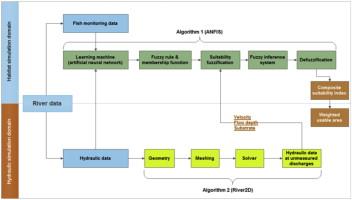Prediction of composite suitability index for physical habitat simulations using the ANFIS method |
| |
| Affiliation: | 1. Institute for Water Management, Hydrology and Hydraulic Engineering, Department for Water–Atmosphere–Environment, BOKU - University of Natural Resources and Life Sciences Vienna, Muthgasse 107, 1190 Vienna, Austria;2. Institute for Hydrobiology and Aquatic Ecosystem Management, Department for Water–Atmosphere–Environment, BOKU - University of Natural Resources and Life Sciences Vienna, Max-Emanuel Straße 17, 1180 Vienna, Austria;1. Christian Doppler Laboratory for Advanced Methods in River Monitoring, Modelling and Engineering, Institute for Water Management, Hydrology and Hydraulic Engineering, Department for Water – Atmosphere – Environment, BOKU - University of Natural Resources and Life Sciences Vienna, Muthgasse 107, 1190 Vienna, Austria;2. Institute of Hydrobiology and Aquatic Ecosystem Management, Department for Water – Atmosphere – Environment, BOKU - University of Natural Resources and Life Sciences Vienna, Max-Emanuelstrasse 17, 1180, Vienna, Austria |
| |
| Abstract: | 
A physical habitat simulation is a useful tool for assessing the impact of river development or restoration on river ecosystem. Conventional methods of physical habitat simulation use the habitat suitability index models and their success depends largely on how well the model reflects monitoring data. One of preferred habitat suitability index models is habitat suitability curves, which are normally constructed based on monitoring data. However, these curves can easily be affected by the subjective opinion of the expert. This study introduces the ANFIS method for predicting the composite suitability index for use in physical habitat simulations. The ANFIS method is a hybrid type of artificial intelligence technique that combines the artificial neural network and fuzzy logic. The method is known to be a powerful approach especially for developing nonlinear relationships between input and output datasets.In this study, the ANFIS method was used to predict the composite suitability index for the physical habitat simulation of a 2.5 km long reach of the Dal River in Korea. Zacco platypus was chosen as the target fish of the study area. A 2D hydraulic simulation was performed, and the hydraulic model was validated by comparing the measured and predicted water surface elevations. The distribution of the composite suitability index predicted by the ANFIS model was compared with that using the habitat suitability curves. The comparisons reveal that the two distributions are similar for various flows. In addition, the distribution of the composite suitability index of the Dal River is computed by the ANFIS method using monitoring data for the other watersheds, namely the Hongcheon River, the Geum River, and the Chogang Stream. The monitoring data for the Chogang Stream, correlation pattern of which was the most similar to that of the Dal River, yielded the distribution of the composite suitability index, which was very close to that obtained using data for the Dal River. This is also supported by the mean absolute percentage error for the difference in the weighted usable areas. |
| |
| Keywords: | Physical habitat simulation Composite suitability index Adaptive neuro-fuzzy inference system (ANFIS) Habitat suitability index Watershed monitoring data |
| 本文献已被 ScienceDirect 等数据库收录! |
|

